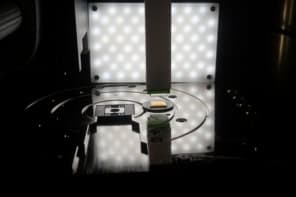
Ferroelectricity can exist in a sheet of material just a few nanometres thick. This new and unexpected discovery by researchers in the US and South Korea could help in the development of new materials for nanoscale electronics.
Ferroelectric materials have permanent electric dipole moments – much like their ferromagnetic counterparts, which have permanent magnetic dipole moments. Ferroelectrics have the potential to be used in a wide range of devices because their dipole moments can be oriented using electric fields, which are much easier to create than the magnetic fields used to manipulate ferromagnetic materials. One possible application is memory chips that store data in terms of the polarization of ferroelectric thin films. A major problem, however, is that these materials cease to be ferroelectric as they become very thin, which limits their usefulness in modern electronic devices.
The researchers, led by Chang Beom Eom of the University of Wisconsin–Madison, have found that a thin film of a material that is normally not electrically polarized can be made polar by taking advantage of existing tiny polar nanoregions within the material. “This happens when the film is made so thin that its whole volume is occupied by these nanoregions,” explains Eom. “When these are electrically aligned in one direction, this leads to a net polarization – and the material becomes ferroelectric.”
The flexoelectric effect
The team’s new discovery stems from its earlier work, in which the researchers discovered naturally occurring polar nanoregions in strontium-titanate films and crystals, which are neither polar nor ferroelectric. “We found that we could reverse the polarization in this material without any applied voltage by simply exerting pressure on the film through the tip of an atomic force microscope,” says team member Alexei Gruverman of the University of Nebraska–Lincoln. “Such voltage-free ferroelectric switching is possible thanks to the ‘flexoelectric effect’, whereby a mechanical-strain gradient induces electrical polarization.”
The researchers wanted to see if the same thing happened in much thinner films of the non-polar material. “We found that we could induce a large flexoelectric effect in this material, but only if the films were very thin,” Eom and Gruverman explain. “To our surprise, we saw that these films behaved almost like ferroelectric ones – that is, they could be polarized not only by applying mechanical strain to them, but also with an applied voltage, and that this polarization was stable. The striking discovery was that the thinner the film, the more stable the polarization, and ferroelectrics typically tend to behave in the opposite way.”
Nanoregion takes over
The researchers say that they immediately connected this observation with their previous work on polar nanoregions, and can now clearly explain how the strain-free ultrathin films of otherwise non-ferroelectric strontium titanate become ferroelectric, says Eom. “As mentioned, when the film’s thickness becomes as small as individual polar nanoregions (which are several nanometres across), the whole volume of the film is occupied by them and the film starts to behave like a ferroelectric,” he says.
The researchers performed ferroelectric measurements, piezoresponse force microscopy and scanning transmission electron microscopy on their samples to confirm their results.
Strontium titanate is an important building block for oxide electronics and has superconducting, 2D gas and magnetic properties, and so is useful for a range of device applications. It also appears to be a good material for solar cells.
Unique or ubiquitous?
Eom and Gruverman say that they do not yet know whether the effect they have observed is unique to strontium titanate. However, they hope that it is valid for other perovskite dielectrics, in which polar nanoregions could be controlled by carefully engineering defect structures in these materials. If this is the case, nanoscale devices in which ferroelectricity is coupled to other properties such as magnetism might be possible.
The discovery is described in Science.
- This article first appeared on nanotechweb.org



